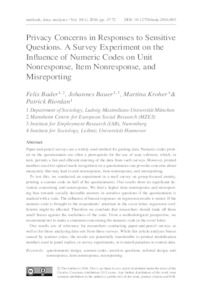|
Privacy concerns in responses to sensitive questions. A survey experiment on the influence of numeric codes on unit nonresponse, item nonresponse, and misreporting
Bader, Felix
;
Bauer, Johannes
;
Kroher, Martina
;
Riordan, Patrick
![[img]](https://madoc.bib.uni-mannheim.de/48815/1.hassmallThumbnailVersion/MDA_Vol10_2016-1_Bader.pdf)  Vorschau |
|
PDF
MDA_Vol10_2016-1_Bader.pdf
- Veröffentlichte Version
Download (1MB)
|
|
DOI:
|
https://doi.org/10.12758/mda.2016.003
|
|
URL:
|
https://madoc.bib.uni-mannheim.de/48815
|
|
Weitere URL:
|
https://www.gesis.org/fileadmin/upload/forschung/p...
|
|
URN:
|
urn:nbn:de:bsz:180-madoc-488150
|
|
Dokumenttyp:
|
Zeitschriftenartikel
|
|
Erscheinungsjahr:
|
2016
|
|
Titel einer Zeitschrift oder einer Reihe:
|
Methoden, Daten, Analysen : MDA
|
|
Band/Volume:
|
10
|
|
Heft/Issue:
|
1
|
|
Seitenbereich:
|
47-72
|
|
Ort der Veröffentlichung:
|
Mannheim
|
|
Verlag:
|
GESIS
|
|
ISSN:
|
1864-6956 , 2190-4936
|
|
Sprache der Veröffentlichung:
|
Englisch
|
|
Einrichtung:
|
Außerfakultäre Einrichtungen > MZES - Arbeitsbereich A
Fakultät für Sozialwissenschaften > Sociological Methodology (Gautschi 2009-)
|
|
Bereits vorhandene Lizenz:
|
 Creative Commons Namensnennung 4.0 International (CC BY 4.0) Creative Commons Namensnennung 4.0 International (CC BY 4.0)
|
|
Fachgebiet:
|
300 Sozialwissenschaften, Soziologie, Anthropologie
|
|
Abstract:
|
Paper-and-pencil surveys are a widely used method for gaining data. Numeric codes printed on the questionnaire are often a prerequisite for the use of scan software, which, in turn, permits a fast and efficient entering of the data from such surveys. However, printed numbers used for optical mark recognition on a questionnaire can provoke concerns about anonymity that may lead to unit nonresponse, item nonresponse, and misreporting.
To test this, we conducted an experiment in a mail survey on group-focused enmity, printing a scanner code on half of the questionnaires. Our results show no significant deviation concerning unit nonresponse. We find a higher item nonresponse and misreporting bias towards socially desirable answers in sensitive questions if the questionnaire is marked with a code. The influence of biased responses on regression results is minor. If the numeric code is brought to the respondents’ attention in the cover letter, regression coefficients might be affected. Therefore we conclude that researchers should trade off these
small biases against the usefulness of the code. From a methodological perspective, we recommend not to make a statement concerning the numeric code in the cover letter.
Our results are of relevance for researchers conducting paper-and-pencil surveys as well as for those analyzing data sets from these surveys. While this article analyzes biases caused by scanner codes, the results are potentially transferable to printed identification numbers used in panel studies, in survey experiments, or to match paradata or context data.
|
 | Dieser Eintrag ist Teil der Universitätsbibliographie. |
 | Das Dokument wird vom Publikationsserver der Universitätsbibliothek Mannheim bereitgestellt. |
 Suche Autoren in Suche Autoren in
BASE:
Bader, Felix
;
Bauer, Johannes
;
Kroher, Martina
;
Riordan, Patrick
Google Scholar:
Bader, Felix
;
Bauer, Johannes
;
Kroher, Martina
;
Riordan, Patrick
ORCID:
Bader, Felix  ORCID: 0000-0002-8265-7289 ORCID: 0000-0002-8265-7289 ; Bauer, Johannes ; Kroher, Martina ; Riordan, Patrick
Sie haben einen Fehler gefunden? Teilen Sie uns Ihren Korrekturwunsch bitte hier mit: E-Mail
Actions (login required)
 |
Eintrag anzeigen |
|
|
 ORCID: 0000-0002-8265-7289 ; Bauer, Johannes ; Kroher, Martina ; Riordan, Patrick
ORCID: 0000-0002-8265-7289 ; Bauer, Johannes ; Kroher, Martina ; Riordan, Patrick



 Creative Commons Namensnennung 4.0 International (CC BY 4.0)
Creative Commons Namensnennung 4.0 International (CC BY 4.0) Suche Autoren in
Suche Autoren in